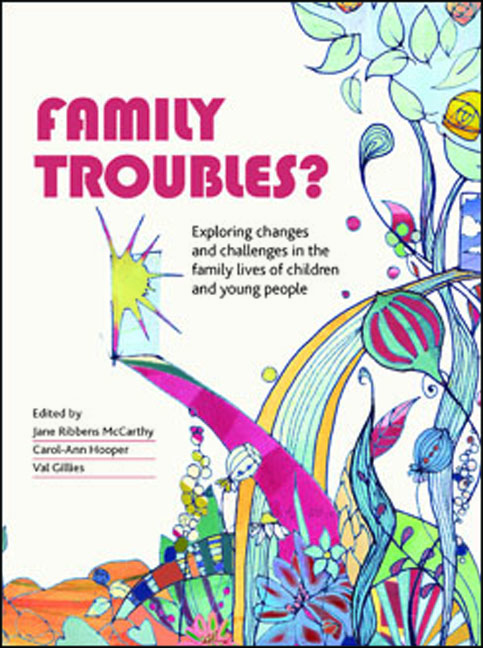Book contents
- Frontmatter
- Contents
- Notes on contributors
- Foreword
- Preface
- 1 Troubling normalities and normal family troubles: diversities, experiences and tensions
- Part One Approaching family troubles ? Contexts and methodologies :Introduction to Part One
- Part Two Whose trouble ? Conteste d definitions and practice: Introduction to Part Two
- Part Three The Normal, The Troubling And The Harmful?: Introduction to Part Three
- Part Four Troubles and transitions across space and culture: Introduction to Part Four
- Part Five Working With Families: Introduction to Part Five
- Index
11 - Troubling loss? Children’s experiences of major disruptions in family life
Published online by Cambridge University Press: 07 September 2022
- Frontmatter
- Contents
- Notes on contributors
- Foreword
- Preface
- 1 Troubling normalities and normal family troubles: diversities, experiences and tensions
- Part One Approaching family troubles ? Contexts and methodologies :Introduction to Part One
- Part Two Whose trouble ? Conteste d definitions and practice: Introduction to Part Two
- Part Three The Normal, The Troubling And The Harmful?: Introduction to Part Three
- Part Four Troubles and transitions across space and culture: Introduction to Part Four
- Part Five Working With Families: Introduction to Part Five
- Index
Summary
Introduction
This article draws on young people's perspectives on extraordinary changes – the disruption of biographies, families and households – that may be experienced as loss. We take it for granted that young people's own insights into the constraints and possibilities of adjusting to, recovering from or repairing such disruptions are of intrinsic value and interest. The focus is not on the psychological mechanism involved in mourning (Bagnoli, 2003) or on how the absent are dealt with in memory (Cait, 2008), but, rather, on the interpersonal, systemic and discursive processes involved in deflecting, minimising or amplifying the trouble loss brings. The theoretical starting point draws from insights shared by a range of sociological understanding of the development of selves (Mead, 1934; Goffman, 1959; Berger and Luckman, 1967; Giddens, 1984; Bourdieu, 1986; Smith, 1987; Holdsworth and Morgan, 2007; Holmes, 2010). This approach places the biographical origins of the self-reflexive self, ‘me’ and ‘I’, in emotionally charged relationships with primary carers during infancy. In childhood, the influences shaping and sustaining the self rapidly open out to a larger constellation of close relationships and other social systems bestowing a sense of belonging, competence and worth, including the education system and other institutions rewarding performance. Scholars of personal life have used various terms to describe the constellation of close relationships that are influential to a sense of self as well as a source of practical and emotional support and ‘capital’ (Bourdieu, 1986): ‘significant others’ (Berger and Luckman, 1967; Ketokivi, 2008), ‘network of care’ (Hansen, 2005), ‘personal communities’ (Wellman et al, 1988; Spencer and Pahl, 2006), ‘connected lives’ (Smart, 2007) and ‘family configurations’ (Widmer and Sapin, 2008). Such personal relationships and wider social systems bestowing belonging and competence are often intertwined. Micro worlds of personal interaction are always framed by institutionalised social and discursive cultural systems, which structure access to resources and ideas, shaping the possibilities for working on and imagining the self. This theoretical approach regards the self and subjectivity as always open to at least partial refashioning. Working with the limits of inner resources and the affordances of wider social and cultural systems, people, children and adults, refresh and remake something of themselves in social interaction with significant others and through their performances.
- Type
- Chapter
- Information
- Family Troubles?Exploring Changes and Challenges in the Family Lives of Children and Young People, pp. 135 - 150Publisher: Bristol University PressPrint publication year: 2013

